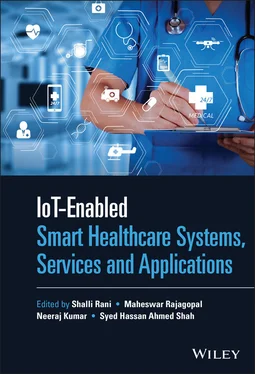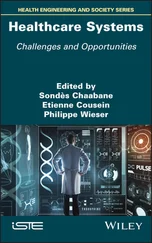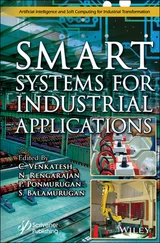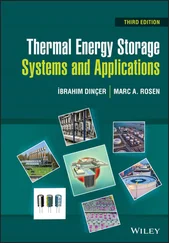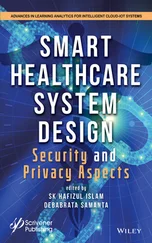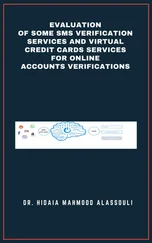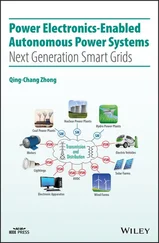IoT-enabled Smart Healthcare Systems, Services and Applications
Здесь есть возможность читать онлайн «IoT-enabled Smart Healthcare Systems, Services and Applications» — ознакомительный отрывок электронной книги совершенно бесплатно, а после прочтения отрывка купить полную версию. В некоторых случаях можно слушать аудио, скачать через торрент в формате fb2 и присутствует краткое содержание. Жанр: unrecognised, на английском языке. Описание произведения, (предисловие) а так же отзывы посетителей доступны на портале библиотеки ЛибКат.
- Название:IoT-enabled Smart Healthcare Systems, Services and Applications
- Автор:
- Жанр:
- Год:неизвестен
- ISBN:нет данных
- Рейтинг книги:4 / 5. Голосов: 1
-
Избранное:Добавить в избранное
- Отзывы:
-
Ваша оценка:
- 80
- 1
- 2
- 3
- 4
- 5
IoT-enabled Smart Healthcare Systems, Services and Applications: краткое содержание, описание и аннотация
Предлагаем к чтению аннотацию, описание, краткое содержание или предисловие (зависит от того, что написал сам автор книги «IoT-enabled Smart Healthcare Systems, Services and Applications»). Если вы не нашли необходимую информацию о книге — напишите в комментариях, мы постараемся отыскать её.
Explore the latest healthcare applications of cutting-edge technologies IoT-Enabled Smart Healthcare Systems, Services and Applications
IoT-Enabled Smart Healthcare Systems, Services and Applications
IoT-enabled Smart Healthcare Systems, Services and Applications — читать онлайн ознакомительный отрывок
Ниже представлен текст книги, разбитый по страницам. Система сохранения места последней прочитанной страницы, позволяет с удобством читать онлайн бесплатно книгу «IoT-enabled Smart Healthcare Systems, Services and Applications», без необходимости каждый раз заново искать на чём Вы остановились. Поставьте закладку, и сможете в любой момент перейти на страницу, на которой закончили чтение.
Интервал:
Закладка:
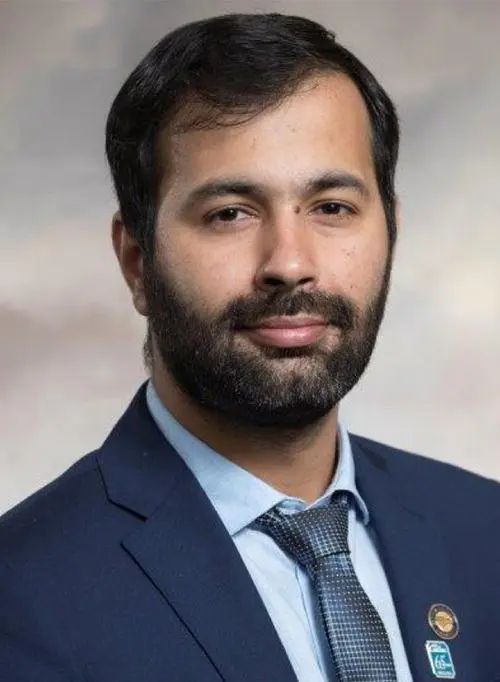
Dr. Syed Hassan Ahmed Shah(SM’18) Ahmed is IEEE Senior Member and ACM Distinguished Speaker. He currently works at JMA Wireless as a product specialist for distributed antenna systems (DAS), CBRS, small cell, and the virtualized RAN product line. Previously, he was an assistant professor in the Department of Computer Science at Georgia Southern University, US, where, he also founded the Wireless Internet and Networking Systems (WINS) lab. Prior to this, he was a Post‐Doctoral Fellow in the Department of Electrical and Computer Engineering, University of Central Florida, Orlando, US. Before moving to the United States, he completed his BS with honors in CS from Kohat University of Science & Technology (KUST), Pakistan, and Master combined PhD degree from the School of Computer Science and Engineering (SCSE), Kyungpook National University (KNU), Republic of Korea (South Korea). In the summer of 2015, he was also a visiting researcher at Georgia Tech, Atlanta, US. Overall, he has authored/coauthored over 200 international publications including journal articles, conference proceedings, book chapters, and three books. In 2016, his work on robust content retrieval in future vehicular networks led him to win the Qualcomm Innovation Award at KNU, Korea. Dr. Hassan’s research interests include sensor and ad hoc networks, cyber‐physical systems, vehicular communications, and future Internet. He has been an appointee of the Board of Governors of the IEEE Vehicular Technology Society as liaison to IEEE Young Professionals society for 2018–2019. Since 2018, he is also an ACM Distinguished Speaker. Furthermore, Dr. Hassan is a Senior IEEE and ACM professional member, has served as a TPC Member or Reviewer in 100+ international conferences and workshops including IEEE Globecom, IEEE ICC, IEEE CCNC, IEEE ICNC, IEEE VTC, IEEE INFOCOM, ACM CoNEXT, ACM MobiHoc, and ACM SAC. Additionally, he has been reviewing papers for 30+ international journals including IEEE Wireless Communications magazine, networks, communications, IEEE Communications Letters , IEEE Sensors Letters , IEEE Transactions on Industrial Informatics , Vehicular Technologies , Intelligent Transportation Systems , Big Data , and Mobile Computing . Moreover, Dr. Hassan has been an editorial member of more than 30 special issues with top‐ranked journals in Communication Society and has served as an editorial board member of KSII Transactions on Internet & Information Systems and Wiley’s Internet Technology Letters , Transactions on Emerging Telecommunications Technologies , IEEE Newsletters on Internet Initiative , Future Directions , and Software Defined Networks .
List of Contributors
Masooma Zehra Syeda Division of Nano & Information Technology Center for Imaging Media Research, KIST(Korea Institute of Science and Technology) Seoul Republic of Korea
Dur‐e‐hassan Syeda Department of Software Engineering Mehran University of Engineering and Technology Jamshoro Sindh Pakistan
Himanshi Babbar Chitkara University Institute of Engineering and Technology Chitkara University Punjab India
Divya Gupta Chitkara University Institute of Engineering and Technology Chitkara University Punjab India
Shalli Rani Chitkara University Institute of Engineering and Technology Chitkara University Punjab India
Syed Hassan Ahmed Shah Product Specialist, JMA wireless USA
Neeraj Kumar Department of Computer Science and Engineering Thapar University Patiala Punjab India
R. Nidhya Department of Computer Science and Engineering, Madanapalle Institute of Technology & Science Madanapalle Andhra Pradesh India
Manish Kumar School of Computer Science and Engineering Vellore Institute of Technology Chennai, Tamil Nadu India
R. Maheswar Dean Research (Assistant), VIT Bhopal University Bhopal India
D. Pavithra Department of Electronics and Communication Engineering, Sri Ramakrishna Institute of Technology Coimbatore, Tamil Nadu India
M. Saravanan Department of Electronics and Communication Engineering, Sri Eshwar College of Engineering Coimbatore, Tamilnadu, India
J. Ajayan Department of Electronics and Communication Engineering, SR University Warangal, Telangana India
R. Maheswar School of Electrical & Electronics Engineering (SEEE), VIT Bhopal University Sehore Madhya Pradesh India
E. Parthasarathy Department of Electronics and Communication Engineering, SRM Institute of Science and Technology Chennai, Tamilnadu India
Shanu Bhardwaj Chitkara University Institute of Engineering and Technology Chitkara University Punjab India
S.N. Panda Chitkara University Institute of Engineering and Technology Chitkara University Punjab India
Priyanka Datta Chitkara University Institute of Engineering and Technology Chitkara University Punjab India
Rajesh Kumar Kaushal Chitkara University Institute of Engineering and Technology Chitkara University Punjab India
Naveen Kumar Chitkara University Institute of Engineering and Technology Chitkara University Punjab India
Amit Sundas School of Engineering, Ajeenkya DY Patil University Pune India
Sumit Badotra School of Computer Science & Engineering, Faculty of Engineering & Technology, Jain University Karnataka India
Chhabildas Madhukar Gajare School of Engineering, Ajeenkya DY Patil University Pune India
Chetna Kaushal Chitkara University Institute of Engineering and Technology Chitkara University Punjab India
Md Khairul Islam Department of Information and Communication Technology Islamic University, Kushtia Bangladesh
Anshu Singla Chitkara University Institute of Engineering and Technology Chitkara University Punjab India
Md Al Amin Department of Computer Science and Engineering Prime University Dhaka Bangladesh
Ravneet Kaur School of Information Technology Deakin University Victoria, Geelong Australia Chitkara University Institute of Engineering and Technology Chitkara University Punjab Rapura India
Ramkumar Ketti Ramachandran Chitkara University Institute of Engineering and Technology Chitkara University Punjab, Rapura India
Robin Doss School of Information Technology Deakin University Victoria, Geelong Australia
Lei Pan School of Information Technology Deakin University Victoria, Geelong Australia
1 The Role of Emerging Technologies in Smart Healthcare
Masooma Zehra Syeda1, Dur‐e‐hassan Syeda2, and Himanshi Babbar3
1 Division of Nano & Information Technology, Center for Imaging Media Research, KIST(Korea Institute of Science and Technology), Seoul, Republic of Korea
2 Department of Software Engineering, Mehran University of Engineering and Technology, Jamshoro, Sindh, Pakistan
3 Chitkara University Institute of Engineering and Technology, Chitkara University, Punjab, India
1.1 Introduction
Environmental pollution is an important factor that affects the health of every age group. Health improvement is an urgent need to improve quality of life. Owing to the advancements in computation and communication technologies, the healthcare sector has benefited handsomely from the available tools and applications [1]. Healthcare‐related actors (doctors, facilitators, practitioners, researchers, and strategic planners) are striving to address the challenges faced by the current healthcare system by continuously struggling with the healthcare system performance. Till date, a plethora of smart tools pertaining to electronic healthcare are used. It is important to note that the healthcare enhancements enable a positive change to become smart healthcare. Sufficient access to healthcare is related to an increment in life expectancy of about 2.0–2.5 years in men and women at age of 65 as reported in China [2]. Many of the research directions at the emergence of data analytics, wireless communication, information security, intelligent networks, and AI‐equipped methods that provide early diagnosis, prevention, and constant treatment of health conditions. These new technologies and techniques are visualized as the basic elements of modern healthcare. Gunther Eysenbach indicated that healthcare is to be improved worldwide and locally with the utilization of information and communication technology [2]. The deliverance of smart healthcare depends on groups of instructed caregivers and emerging technology mediums. Healthcare systems that are routinely used nowadays were not long ago just a vision beyond our technological frontier. Therefore, the emergence of technology and digital systems (consisting of many heterogeneous sensors and computing devices) has created a chance to transform traditional healthcare systems with Internet‐based systems to harness the benefits of cutting‐edge technologies. Smart healthcare leverages these new emerging technologies to transform the traditional medical measures. The patient will experience better care, and they are fundamentally changing how medical decisions and treatments are rendered. Technology is playing a significant role in the vital fields of medicine and targets the services of smart healthcare in three different sectors: clinical institutions, regional health institutes, and individual family members. These entities are interconnected through applications that consist of virtual assistance, smart health centers, patient diagnosis, and patient treatment. Deloitte indicated that technologies such as nanotechnology, genomics, blockchain, augmented reality (AR), additive manufacturing, robotics, and cognitive computing made medical care less expensive and more versatile for caretakers and patients. The report also indicated that new devices (both handheld and wearable) make it possible to collect the patients’ data remotely in an efficient way [3].
Читать дальшеИнтервал:
Закладка:
Похожие книги на «IoT-enabled Smart Healthcare Systems, Services and Applications»
Представляем Вашему вниманию похожие книги на «IoT-enabled Smart Healthcare Systems, Services and Applications» списком для выбора. Мы отобрали схожую по названию и смыслу литературу в надежде предоставить читателям больше вариантов отыскать новые, интересные, ещё непрочитанные произведения.
Обсуждение, отзывы о книге «IoT-enabled Smart Healthcare Systems, Services and Applications» и просто собственные мнения читателей. Оставьте ваши комментарии, напишите, что Вы думаете о произведении, его смысле или главных героях. Укажите что конкретно понравилось, а что нет, и почему Вы так считаете.
